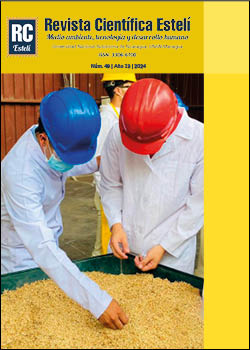The Ecomuseum: a window to the past and a driver of sustainable development
DOI:
https://doi.org/10.5377/esteli.v13i49.17883Keywords:
Sustainable development, tourism, heritage, ecomuseumAbstract
This literature review article aims to analyze the epistemology of the term “Ecomuseum” which was introduced by Georges-Henri Reviere and Hugo de Varin (1971), who indicate that it allows the promotion of sustainability, participation and community empowerment through innovative and shared approaches to the conservation of cultural and natural heritage. Its main function is the creation of a museum center focused on individual, regional, community identification; it was established with the participation of residents to promote the welfare and development of the local community. This unique approach extends to the study, knowledge and understanding of nature and contributes to decision making on how nature is constructed and how it is used in practice, taking into account its benefits and beneficial effects. This theory also contributes to the cultural, social and economic stability of communities through active public participation. The main bibliographic sources consulted for this purpose focused on practices, including the processes implemented for the formation of ecomuseums. The understanding of this term is closely related to the knowledge of strategies and actions for the continuous improvement of tourism development through practices that preserve the cultural and natural heritage of rural communities. The creation of the term “ecomuseum” makes it possible to evaluate this form of museum as a means of preserving cultural and natural heritage.
Downloads
References
Borghi, B. (2017). Ecomuseos y mapas de comunidad: un recurso para la enseñanza de la historia y el patrimonio. Estudios Pedagógicos (Valdivia), 43(4), 251–275. https://doi.org/10.4067/s0718-07052017000400013
Carmona, A. M. A. (2011). Los museos comunitarios participativos. Una aproximación a la Nueva Museología. Cultura, 25, 113–125. http://www.fcctp.usmp.edu.pe/cultura/imagenes/pdf/25_5.pdf
Desvallées, A., & Mairesse, F. (2010). Conceptos claves de museología.
Eve, M. (2023). Ecomuseo y sus principios básicos. 10 Febrero 2023. https://evemuseografia.com/2023/02/10/ecomuseos-y-sus-principios-basicos/
EVE, M. e I. (2016). Ecomuseo, más que una palabra. 21 Noviembre 2016. https://evemuseografia.com/2016/11/21/ecomuseo-mas-que-una-palabra/
EVE, M. e I. (2017). Ecomuseo: museo sin paredes. 16 Enero 2017. https://evemuseografia.com/2017/01/16/ecomuseos-museos-sin-paredes/
EVE, M. e I. (2023). Nueva Museología: Participación y transformación cultural. https://evemuseografia.com/2023/09/20/nueva-museologia-participacion-y-transformacion-cultural/
Fernández, J., González, P. A., & Narvajas, C. O. (2014). La Ponte Ecomuseu: una herrameinta de desarrollo rural basada en al socialización del patrimonio cultural. 2, 15.
Graybeal, L. (2010). La Combinación de Lugar y Voz en los Ecomuseos: Educando a Comunidades y Visitantes en el Nuevo Museo La Combinación de Lugar y Voz en los Ecomuseos : Educando a Comunidades y Visitantes en el Nuevo Museo. 3(2).
Gutiérrez, R., y Martínez, N. R. (2019). Equipamientos para la educacion ambiental: los museos y el ecomuseo recursos en el conocimiento del patrimonio natural y cultural. 7(1), 3–14.
Mendez, L. R. A. (2019). El ecomuseo como comunidad educadora. 12 Agosto 2019. https://www.linkedin.com/pulse/el-ecomuseo-como-comunidad-educadora-raul-andrés-mendez-lugo/?originalSubdomain=es
Méndez Lugo, R. A. (2017). El ecomuseo como comunidad educadora. https://www.linkedin.com/pulse/el-ecomuseo-como-comunidad-educadora-raul-andrés-mendez-lugo/
Mendoza, H. M., Talavera, A. S., & Castellano, J. M. P. (2021). The social benefit of ecomuseums for a territory: The cultural community development project of la Aldea as a case study. Vegueta, 21(1), 183–211. https://doi.org/10.51349/veg.2021.1.08
Navajas, C. O. (2015). Características de los Ecomuseos ( Ecomuseum Features ) Características de los Eco museos. December.
Navajas, C. Ó. (2012). La museología social como herramienta del cambio en los museos de Japón. 4, 241–255. http://www.uam.es/mikel.asensio
Navajas, C. Ó. (2020). Nueva museología y museología social Una historia narrada desde. September.
Ochoa Romero, M. E., Erráez Alvarado, J. L., Ordoñez Ocampo, B. P., & Espinoza Freire, E. E. (2021). Los Museos en la enseñanza de la historia. 3(2), 6.
Ortiz Maciel, D. (2000). El ecomuseo. Ciencias & Letras, 61–101.
Torres, M. A. (2012). El Diseño en la comunicación del patrimonio cultural. 1–228.
UNESCO. (1985). Imágenes del ecomuseo. Museum, 4(148).
UNESCO. (2014). INDICADORES UNESCO DE CULTURA PARA EL DESARROLLO. https://es.unesco.org/creativity/sites/creativity/files/iucd_manual_metodologico_1.pdf
Downloads
Published
Issue
Section
License
Copyright (c) 2024 Revista Científica Estelí

This work is licensed under a Creative Commons Attribution-NonCommercial-ShareAlike 4.0 International License.

